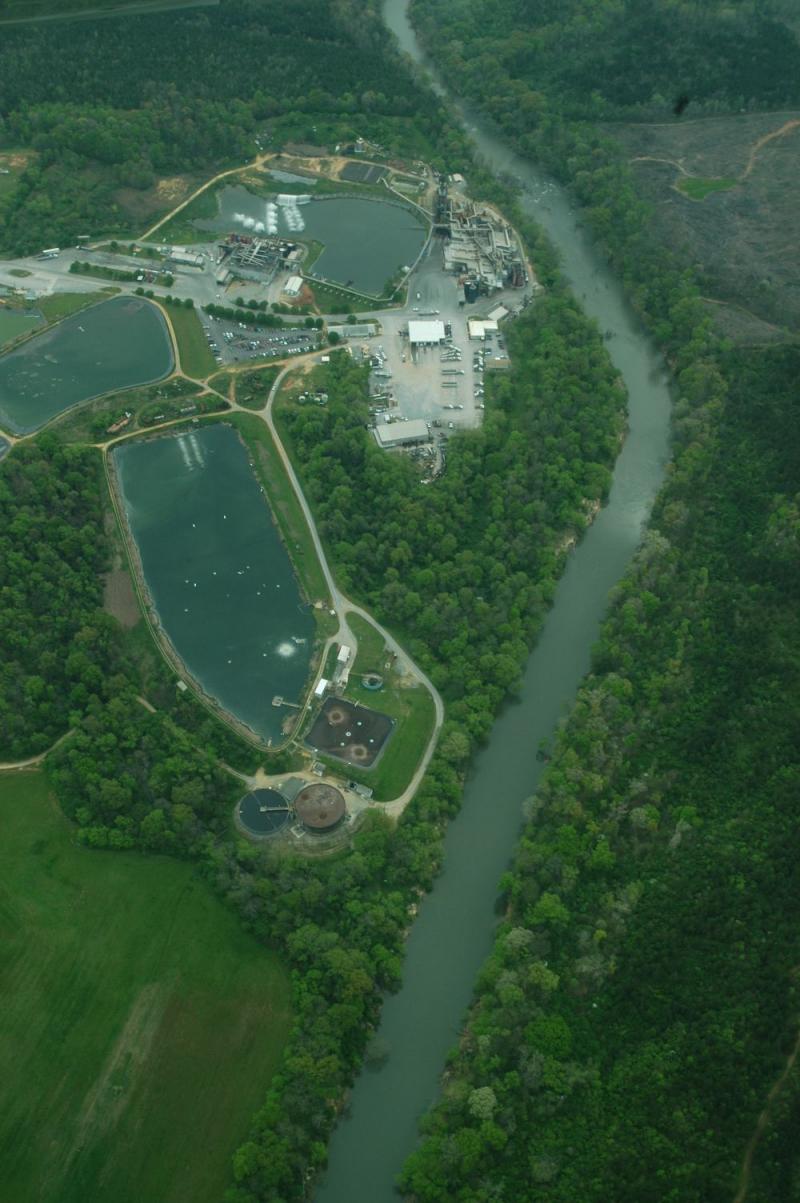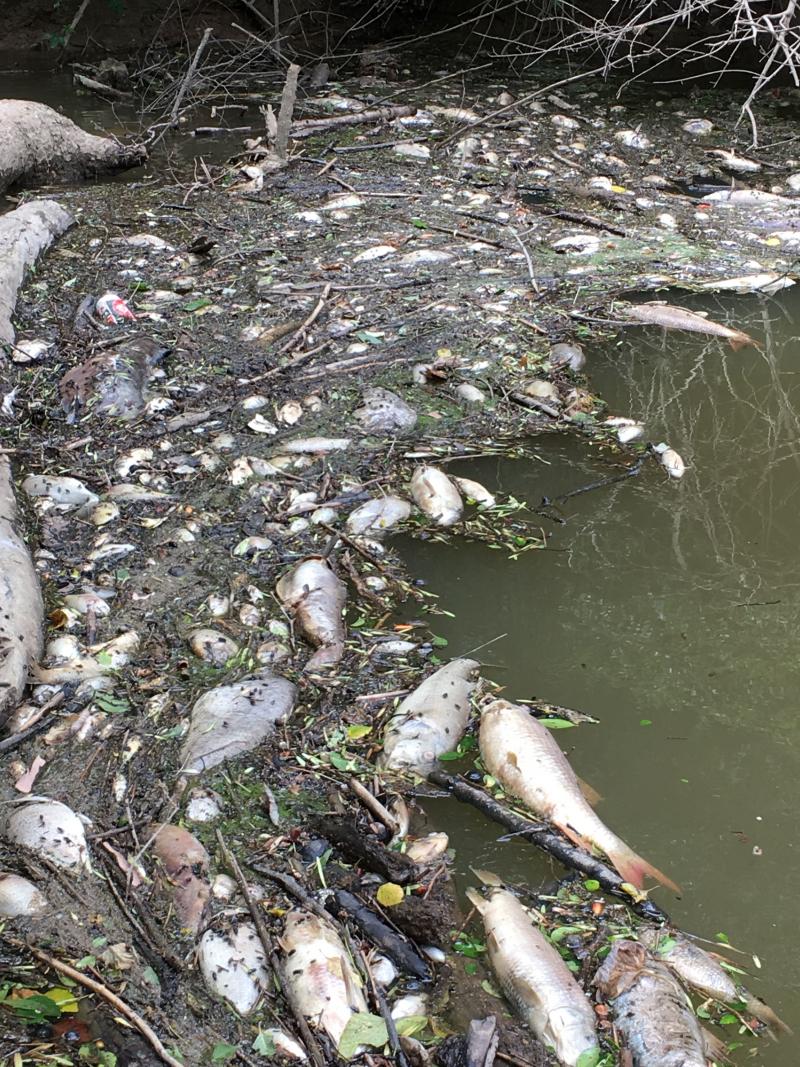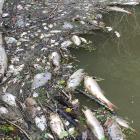The Black Warrior River has died many deaths. And the Mulberry Fork, one of its headwaters, is the nexus of that cyclical dying. On 6 June 2019, a Tyson Farms chicken rendering plant in Hanceville, Alabama, spilled approximately 220,000 gallons (close to 832,900 liters) of wastewater into the Mulberry Fork, killing a conservatively estimated two hundred thousand fish and “fouling the Mulberry so completely that it became unusable for over 50 miles [80.5 kilometers] downstream” (Black Warrior Riverkeeper). “Unusable” is an important and contested term here not just in the sense of fishing, sport, and play, but also because the river is a major source of drinking water for at least six cities (use the map below for context).

Aerial photograph of the Tyson Rendering Plant in Hanceville, Alabama.
Aerial photograph of the Tyson Rendering Plant in Hanceville, Alabama.
© Nelson Brooke, Black Warrior Riverkeeper. Flight by SouthWings.org.
Used by permission
The copyright holder reserves, or holds for their own use, all the rights provided by copyright law, such as distribution, performance, and creation of derivative works.
While the exact constitution of Tyson’s wastewater remains opaque for the public, this partially-treated, anerobic effluent kills by dissolving oxygen in the river water, a fluvia-cide by drowning. In reality-bending corporate denialism, Tyson wrote to the locals: “We want residents to understand [that the fish kill] was due to low levels of oxygen in the water and not because of the release of man-made chemicals.” Their plant, located on the banks of Dave Young Creek, a small tributary running into the Mulberry Fork, ponds its wastewater only meters from the waterway. The wastewater spilled from a broken pipe as it was being transported from one noxious lagoon to another. Tyson blames their pipeline contractors.
For kilometers downstream, corpses rose to the surface, accumulating in massive stinking floats. Land-dwellers smelled the disaster before understanding it. While Tyson assured the public that the Mulberry Fork would be usable with the return of oxygen, the Alabama Department of Environmental Management (ADEM) tested water quality at several locations past the spill, revealing concentrations of E. coli bacteria up to 30 times the level considered safe for swimming and contact by the state. Unfortunately, as revealed by the Black Warrior Riverkeeper, the ADEM failed to make this information public until months after initial testing. Several parties have since taken legal action against Tyson, alleging unreasonable disruption, danger, and illness. Mark Griffin, who owns a boat shop on the river, claims to have spent over 80 days in the hospital receiving surgical care for bacterial infections as a direct result of consuming the river’s water (Killian 2020). And, as most news coverage failed to acknowledge, the massive fallout in marine ecology is irrevocable.
Fish can’t file lawsuits. One way in which Tyson could be held financially accountable for these other-than-human deaths is through replacement fees for each fish, with values determined by the American Fisheries Society. A small catfish, say, could be valued at less than $1, while a large gar could be valued at over $10 (Hodgin 2019). Still, these amounts are essentially negligible for Tyson, a corporation worth many billions. Not to mention, the ADEM has a maximum civil administrative penalty value of just $250,000, which is why the Alabama Attorney General, the ADEM, and the Alabama DCNR are currently taking Tyson to civil court (Hodgin 2019). The cultural toll this corporate negligence takes on small-town, riverside Alabama is another concern. “There are so many good things [about the river],” one local human put it. “We just can’t … continue to let people from the outside come in and take [the river] from us” (Hodgin 2019). Industry is ostensibly from the outside.
This is one of the paradoxes of the US Deep South: strong, insider regionality and attachment to land (over)matched by predominantly conservative politics that undercut environmental protections in favor of corporate investment. The Black Warrior River is named after Chief Tuskaloosa, translated from the Choctaw, who fought against the sixteenth-century Spanish colonizer Hernando de Soto. White, Southern attachments to the land are built over this colonization and consistently fail to acknowledge more longstanding relations between humans, landscapes, and non-human flora and fauna. Perhaps this Anthropocenic devaluation is one explanation why the Mulberry Fork can be prized culturally as well as poisoned by Tyson, power plants, and coal mines, landing Black Warrior on the list of America’s Most Endangered Rivers in 2013 (Black Warrior Riverkeeper). This is not the Mulberry’s first fish kill by industrial poisoning, and it almost certainly won’t be the last (Sack 2016).
Interactive map of ADEM water quality testing locations along the Mulberry Fork. Map by Google and Nelson Brooke, Black Warrior Riverkeeper.
So far, no corporations have been harmed in the making of this long disaster, and Alabama lawmakers tend to play it safe when it comes to maintaining the state’s corporate investments and their voters’ demands for high-paying, blue-collar jobs. Tyson remains to this day unpunished and unaccountable. Groups like The Nature Conservancy, Sipsey Heritage Commission, Black Warrior Riverkeeper, and Friends of the Locust Fork River work to advocate for the rivers. Yet, they fight against the political grain of even the people who seem to care very deeply about these rivers. Within this theater of grassroots surveillance and activism, the river’s many deaths, and the state’s failures to exact corporate accountability, the Alabama citizenry will continue deciding with their attention and votes whether this region will remain one of the most biodiverse in North America or the stomping grounds of Big Industry. It cannot remain both. Supporting grassroots organizations looking after the rivers makes for an excellent conservancy action plan.
See the “further readings” for more on these tensions as well as histories of the South’s corporate investments over and against environmental regulation.
How to cite
Reich, Nicholas Tyler. “Tyson Kills the Mulberry Fork.” Environment & Society Portal, Arcadia (Spring 2021), no. 16. Rachel Carson Center for Environment and Society. doi:10.5282/rcc/9294.
ISSN 2199-3408
Environment & Society Portal, Arcadia
 This work is licensed under a Creative Commons Attribution 4.0 International License.
This work is licensed under a Creative Commons Attribution 4.0 International License.
2021 Nicholas Tyler Reich
This refers only to the text and does not include any image rights.
Please click on an image to view its individual rights status.
- Boyd, William, and Michael Watts. “Agro-Industrial Just-in-Time: The Chicken Industry and Postwar American Capitalism.” In Globalising Food: Agrarian Questions and Global Restructuring, edited by David Goodman and Michael J. Watts, 192–225. London: Routledge, 1997.
- Cobb, James C. The Selling of the South: The Southern Crusade for Industrial Development, 1936–90. Champaign: University of Illinois Press, 1993.
- Hauter, Wenonah. Foodopoly: The Battle over the Future of Food and Farming in America. New York: The New Press, 2014.
- Leonard, Christopher. The Meat Racket: The Secret Takeover of America’s Food Business. New York: Simon & Schuster, 2014.
- Simon, Bryant. “Chickenization and Public Ill-Health in the American South.” Southern Studies 25 (Fall/Winter 2018): 55–77.
- Simon, Bryant. The Hamlet Fire: A Tragic Story of Cheap Food, Cheap Government, and Cheap Lives. New York: The New Press, 2017.









